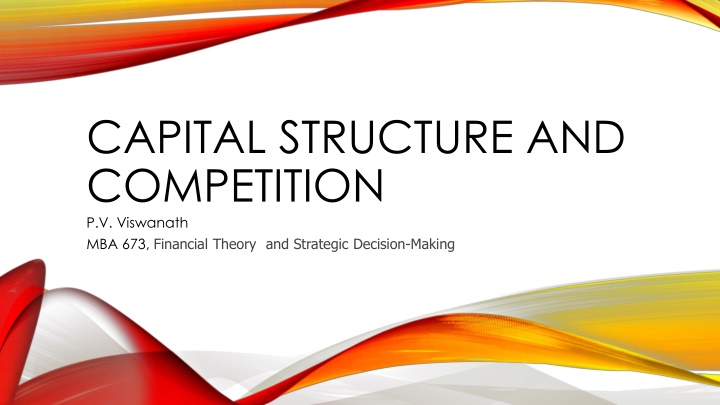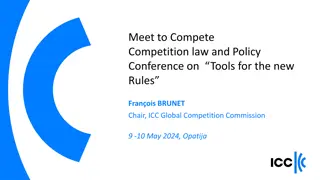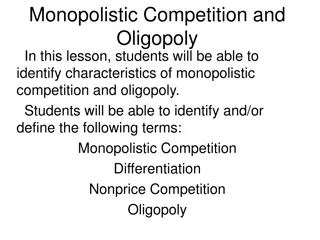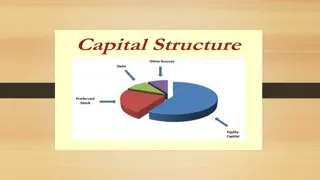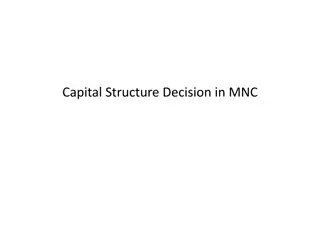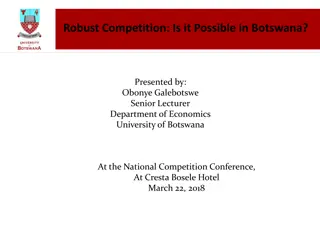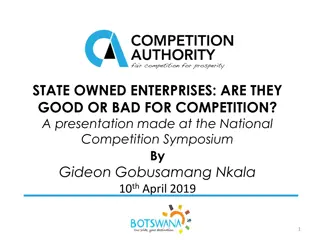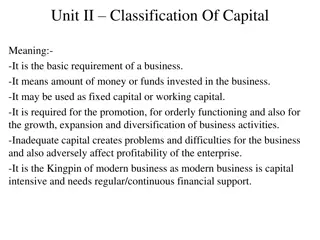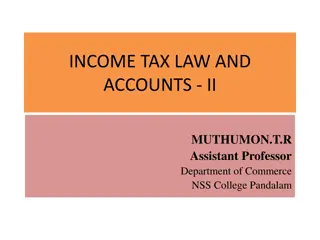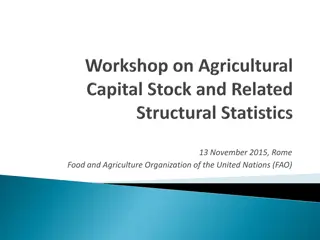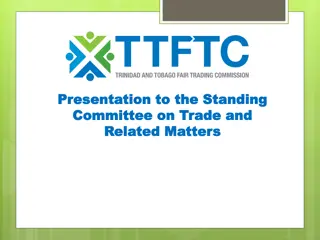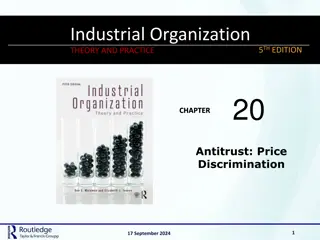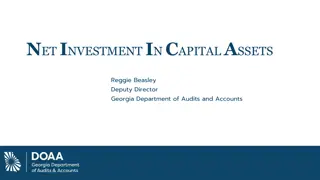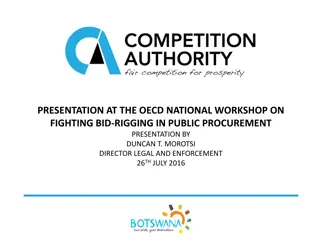CAPITAL STRUCTURE AND COMPETITION
Dive into the intricate relationship between capital structure and competition within financial theory and strategic decision-making. Explore the impact of these dynamics on businesses and markets, and gain insights into making informed financial decisions. Learn from the expertise shared in the content to enhance your understanding of this complex subject area.
Download Presentation

Please find below an Image/Link to download the presentation.
The content on the website is provided AS IS for your information and personal use only. It may not be sold, licensed, or shared on other websites without obtaining consent from the author.If you encounter any issues during the download, it is possible that the publisher has removed the file from their server.
You are allowed to download the files provided on this website for personal or commercial use, subject to the condition that they are used lawfully. All files are the property of their respective owners.
The content on the website is provided AS IS for your information and personal use only. It may not be sold, licensed, or shared on other websites without obtaining consent from the author.
E N D
Presentation Transcript
CAPITAL STRUCTURE AND COMPETITION P.V. Viswanath MBA 673, Financial Theory and Strategic Decision-Making
GAME THEORY Game theory is the study of strategic decision making. More formally, it is the study of mathematical models of conflict and cooperation between intelligent rational decision-makers. Game Theory is used to analyze how firms interact but has many other applications. (Some slides taken from Michael Conlin, online and Mike Shor.)
GAME THEORY TERMINOLOGY In game theory, a strategy is a decision rule that describes the actions a player will take at each decision point. A representation of a game indicating the players, their possible strategies, and the payoffs resulting from alternative strategies, called Normal Form Game is usually used to represent simple games. Let s see how this works with a prisoner s dilemma, presented as a normal form game.
EXAMPLE 1: PRISONERS DILEMMA (NORMAL FORM OF SIMULTANEOUS MOVE GAME) Martha s options Confess Don t Confess M: 2 years P: 2 years M: 1 year P: 10 years Peter s Options Don t Confess Confess M: 10 years P: 1 year M: 6 years P: 6 years Confess (1<2) Confess (6<10) What is Peter s best option if Martha doesn t confess? What is Peter s best option if Martha confess? A dominant strategy that is optimal independent of what the opponent s does
EXAMPLE 2: PRICE SETTING GAME Firm B s options Low Price High Price Low Price 0 , 0 50 , -10 Firm A s Options High Price -10 , 50 10 , 10 Is there a dominant strategy for Firm B? Is there a dominant strategy for Firm A? Low Price Low Price
NASH EQUILIBRIUM If both players have dominant , then that will most likely be what happens in equilibrium? But what if there are no mutually dominant strategies? In this case, John Nash, came up with an equilibrium, which, he suggested, could describe outcomes. This is called a Nash equilibrium. A Nash equilibrium is a condition describing a set of strategies in which no player can improve her payoff by unilaterally changing her own strategy, given the other player s strategy. In other words, every player is doing the best they possibly can given the other player s strategy. If a pair of dominant strategies exist, the equilibrium consisting of those two strategies will also be Nash, but not all Nash equilibria correspond to dominant strategies. Nash equilibria don t always exist for a given game, but if they do, then there is a strong argument that that would describe the actual outcome of the game. (But sometimes there can be more than one Nash equilibrium!)
EXAMPLE 1: NASH? Martha s options Confess Don t Confess 2 years , 2 years 10 years , 1 year Peter s Options Don t Confess Confess 1 year , 10 years 6 years , 6 years One Nash Equilibrium is: (Confess, Confess) Are there any other Nash equilibria?
EXAMPLE 2: NASH? Firm B s options Low Price High Price Low Price 0 , 0 50 , -10 Firm A s Options High Price -10 , 50 10 , 10 Nash Equilibrium: (Low Price, Low Price) Are there any other Nash equilibria?
COMMITMENT GAMES We will now look at some games and examine the role of involvement, commitment, and other devices in the resolution of uncertainty in these games.
INVOLVEMENT, COMMITMENT AND STRATEGY Consider the following chicken game: Manny Swerve Tie, Tie Win, Lose Straight Lose, Win Crash, Crash Swerve Straight Danny Because the loss from swerving is so trivial compared to the crash that occurs if nobody swerves, the reasonable strategy would seem to be to swerve before a crash happens. Yet, knowing this, if one believes one's opponent to be reasonable, one may well decide not to swerve at all, in the belief that he will be reasonable and decide to swerve, leaving the other player the winner. This game has no symmetric Nash equilibrium in pure strategies. If Manny is going to swerve, then Danny should go straight. If Manny is going to go straight, then Danny should swerve (assuming losing is better than crashing). In other words, there is unresolvable uncertainty in this game, as currently stated. How can the uncertainty be resolved?
COMMITMENT AND STRATEGY One tactic in the game is for one party to signal their intentions convincingly before the game begins. For example, if one party were to ostentatiously disable their steering wheel just before the match, the other party would be compelled to swerve. This shows that, in some circumstances, reducing one's own options can be a good strategy. One real-world example is a protester who handcuffs himself to an object, so that no threat can be made which would compel him to move (since he cannot move). Another example, taken from fiction, is found in Stanley Kubrick's Dr. Strangelove. In that film, the Russians sought to deter American attack by building a "doomsday machine," a device that would trigger world annihilation if Russia was hit by nuclear weapons or if any attempt were made to disarm it. However, the Russians failed to signal they deployed their doomsday machine covertly. Obviously, this will not elicit the desired response from the opponent, i.e. backing down. Revelation of the signal is key. Source: Wikipedia
COMMITMENT VS. INVOLVEMENT Two firms considering market entry: Market potential is $10 million NPV profits Entry costs $7 million; if both enter, both firms lose. Them In Out 3 , 0 0 , 0 In Out -2 , -2 0 , 3 Us It is in our best interest to stay out if we think that the other firm will enter. So this is like the chicken game. Mike Shor Game Theory & Business Strategy
INVOLVEMENT How can we strategically resolve this uncertainty? Consider making a small initial investment: Invest first $1 million to deter entry, which is lost if we then quit. Them In Out 3 , 0 -1 , 0 In Out -2 , -2 -1 , 3 Us It is still in our best interest to stay out if we think that the other firm will enter. This level of involvement is insufficient: we still have uncertainty that remains unresolved . Mike Shor Game Theory & Business Strategy
CREDIBLE COMMITMENT Now suppose we make a larger initial investment: Invest first $3 million to deter entry, which amount is lost if we then quit. Them In Out 3 , 0 -3 , 0 In Out -2 , -2 -3 , 3 Us Now, it is our dominant strategy to enter regardless of what the other firm will do. By reducing our own payoffs from staying out, we have committed to entry. This is like a first-mover advantage. Mike Shor Game Theory & Business Strategy
REDUCING PAYOFFS: CONTRACTING Consider another example of a credible commitment. Suppose you don t want to pay more than $200 million for an acquisition target. It is known that you can afford payments of $20 million/yr. for 20 years; if the interest rate is 7%, this means that you can afford $211.88m (PV of $20/yr. for 20 years at 7%). How can you hold out for $200m.? Suppose you finance takeover for 20 years at 7% Add penalty: if amount greater than $200 million, +1.5 points on interest rate Annual Payments: $200 million: $18.8 million / year $210 million: $19.82 million / year still affordable But with penalty: $22.19 million / year -- unaffordable So it s clear that the acquirer will not pay more than $200m. This is, therefore, a credible commitment.
COMMITMENT WITH FINANCING POLICY Managers have an incentive to take negative NPV projects if they have private benefits (from perks) from firm investment. This would discourage outside investment and might even discourage good employees from working for the firm, if we assume that good employees would rather work for profitable firms. How would resolve this problem? One solution is for the firm to take on debt. The existence of debt means that managers are forced to choose profitable projects. Else the firm would be forced into bankruptcy and possibly liquidation and managers would lose their firm-specific human capital. Investors/employees would have reason to worry about suboptimal actions by management; to counteract this, managers can use debt as a commitment device. By taking on debt, managers commit to take on profitable projects. This is the basis for Michael Jensen s Free Cashflow Hypothesis.
